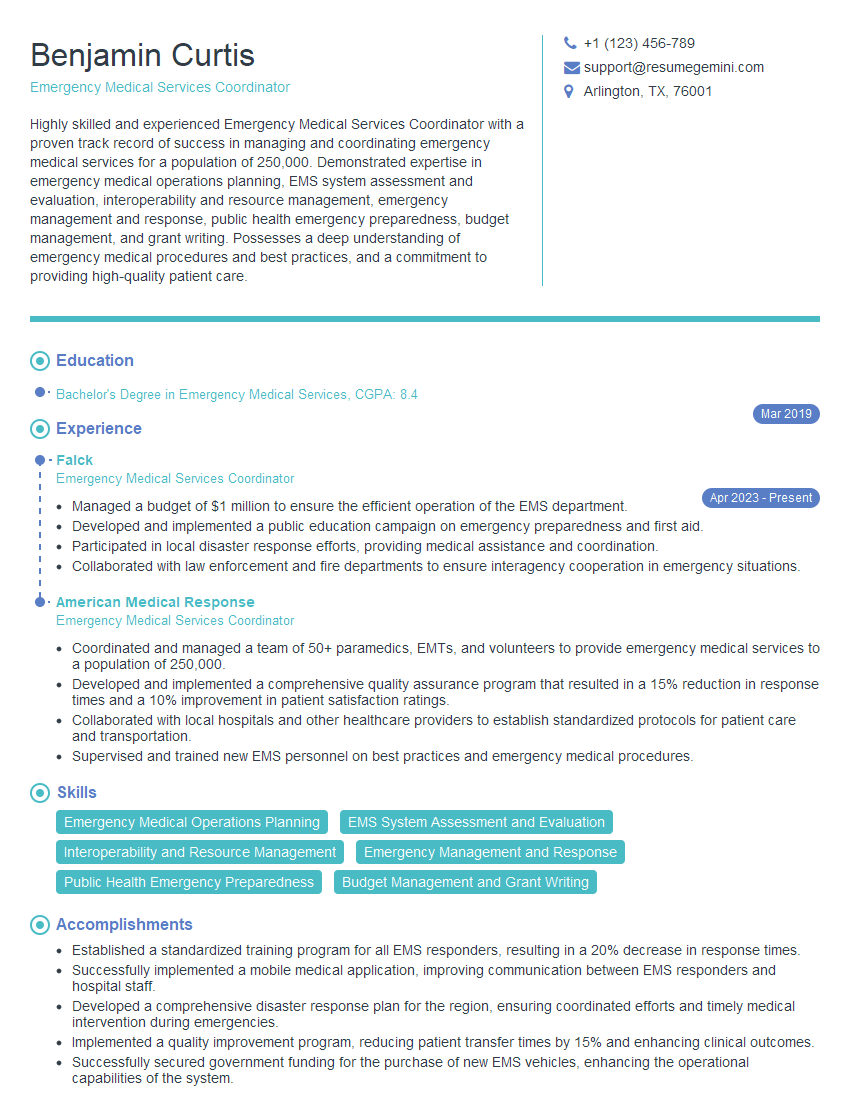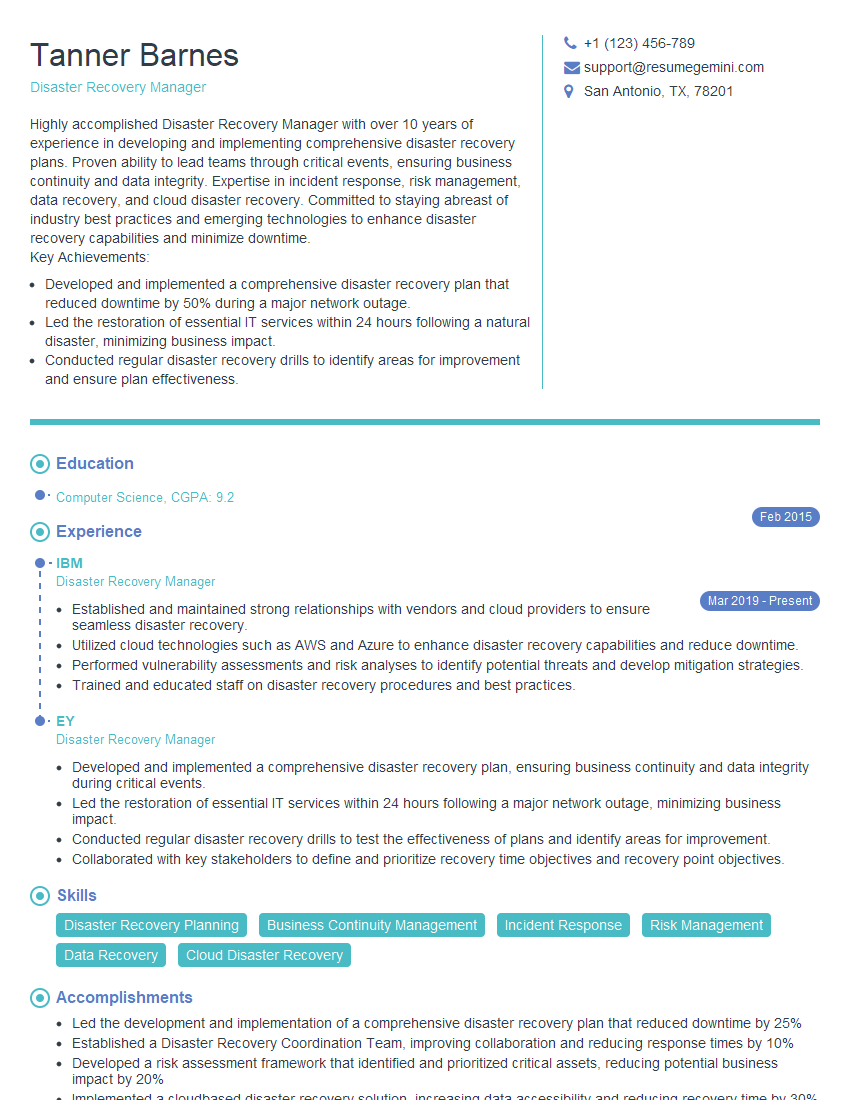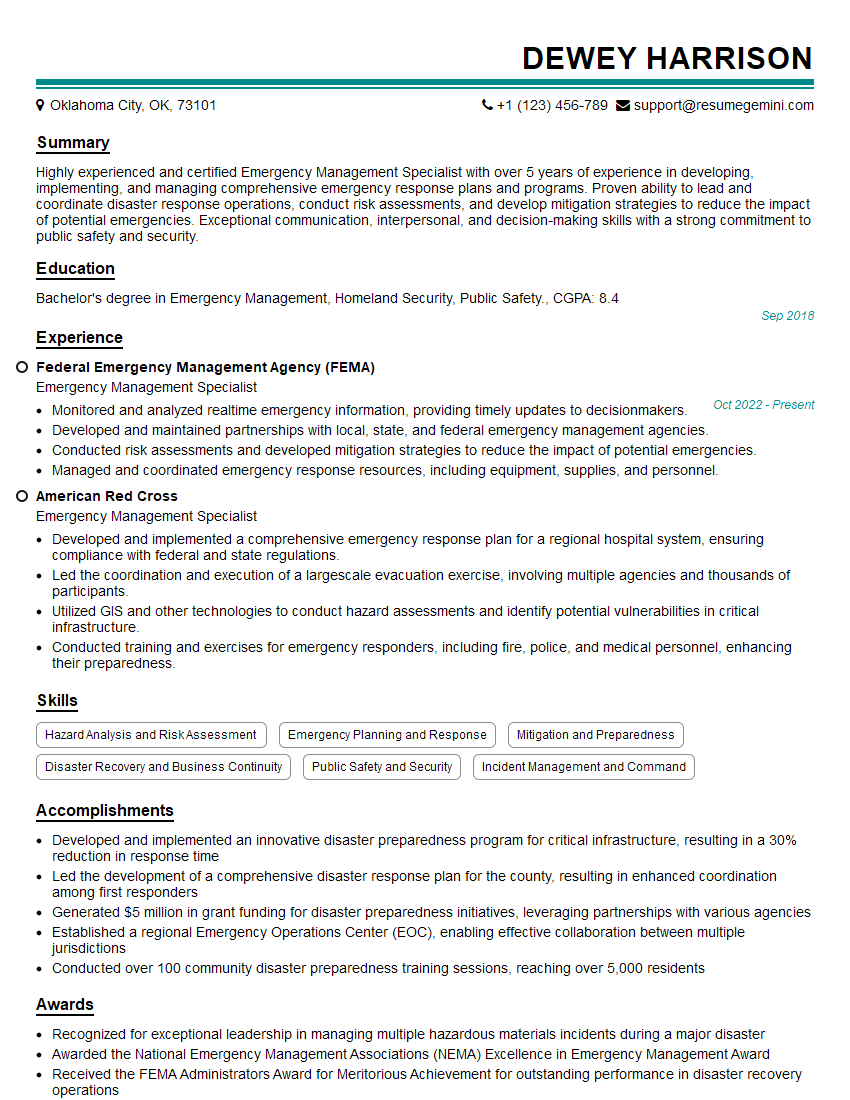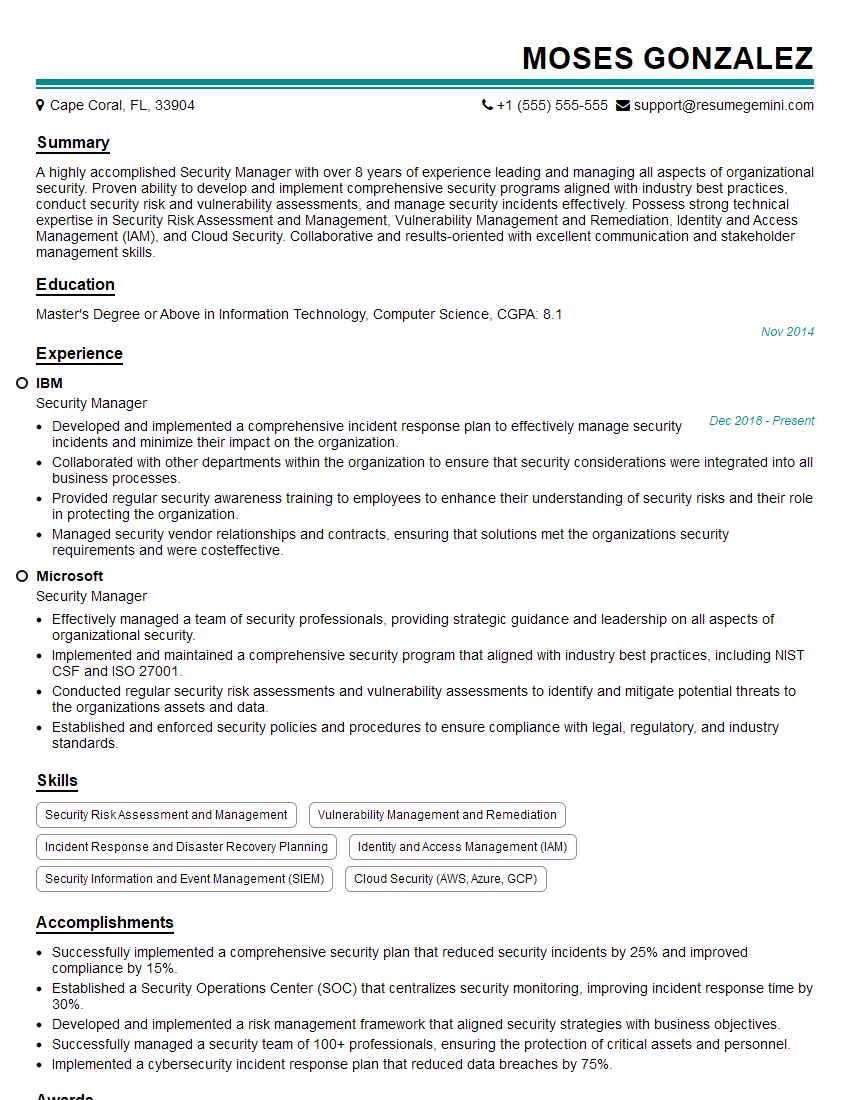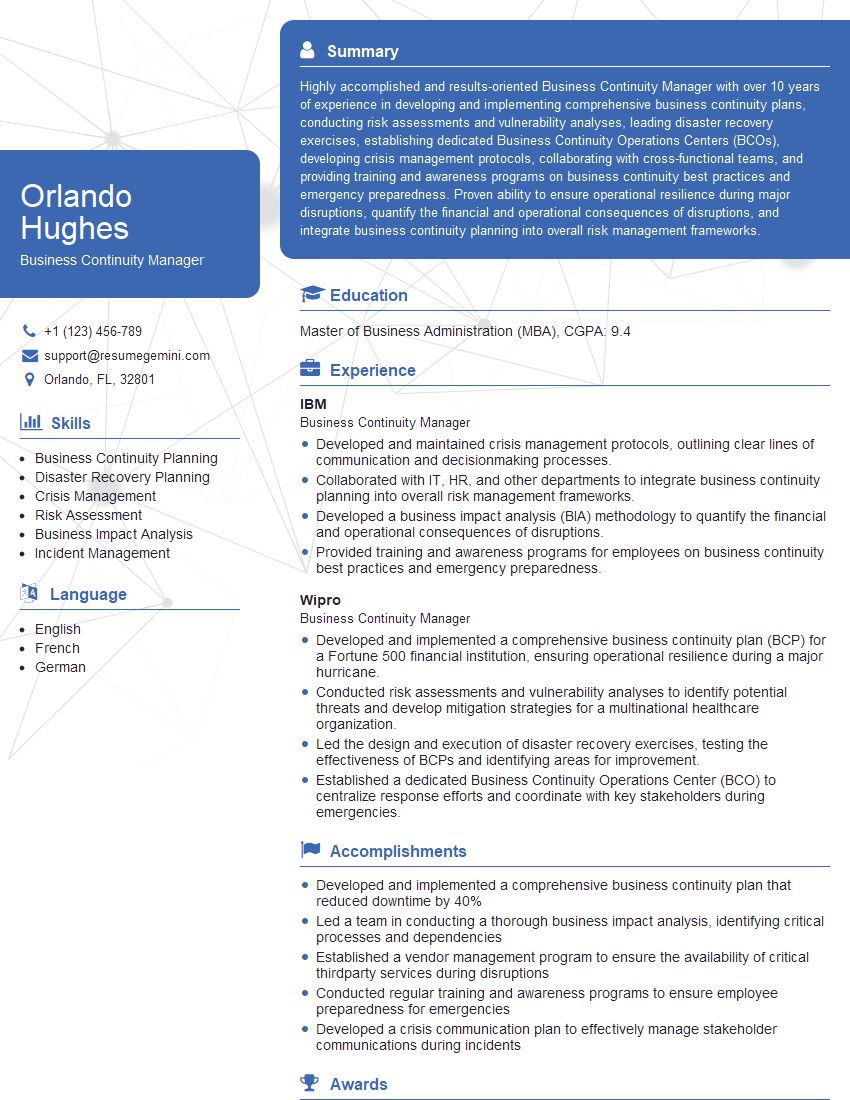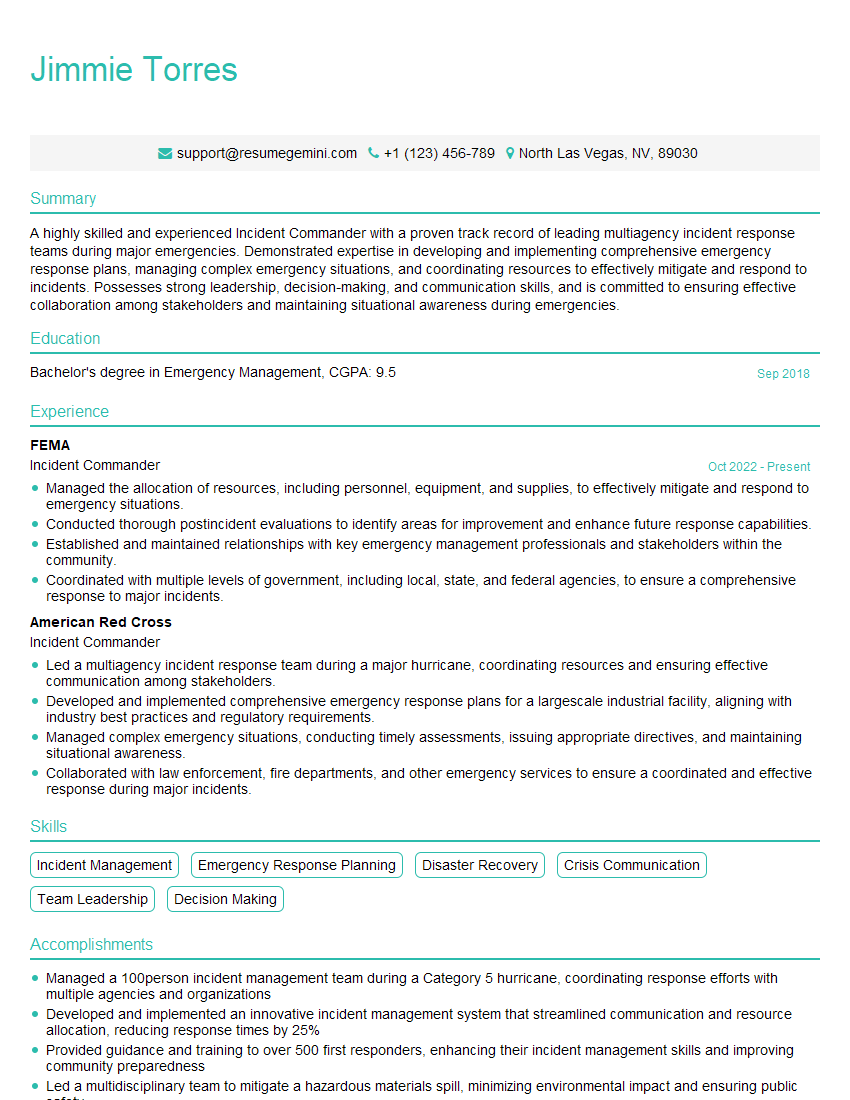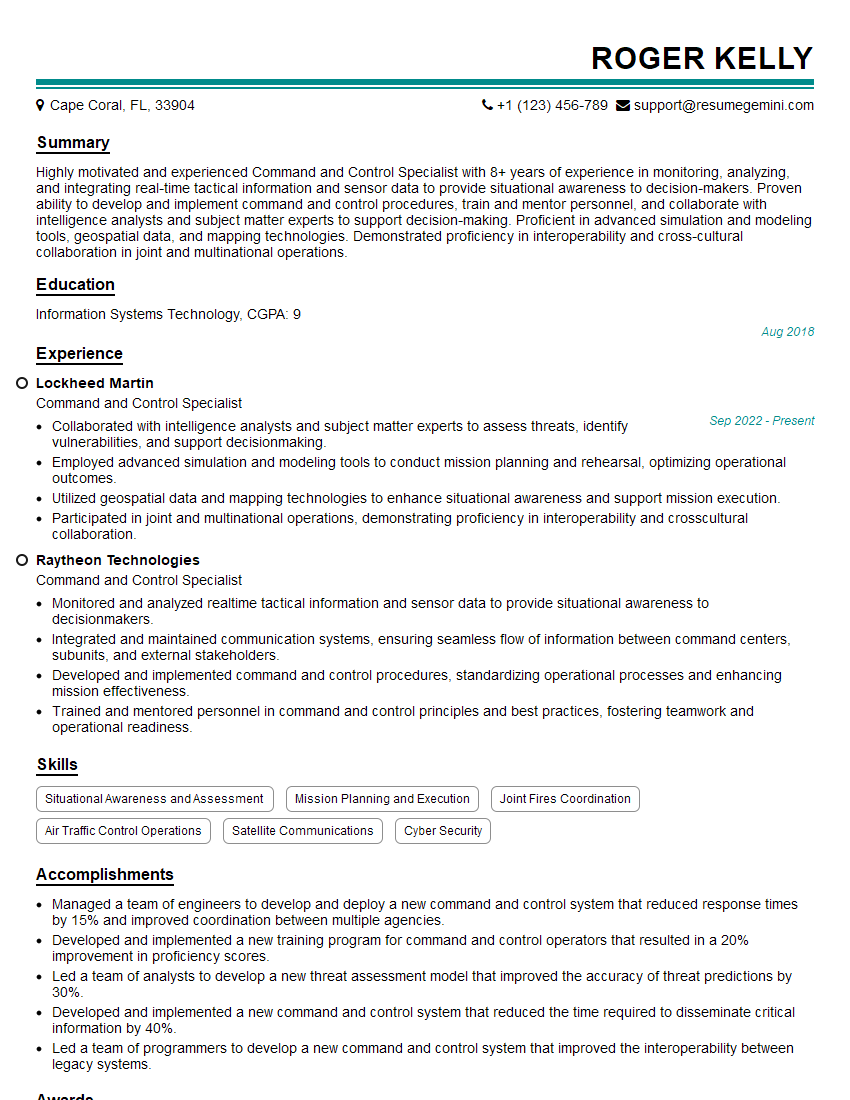Cracking a skill-specific interview, like one for Emergency Operations Procedures, requires understanding the nuances of the role. In this blog, we present the questions you’re most likely to encounter, along with insights into how to answer them effectively. Let’s ensure you’re ready to make a strong impression.
Questions Asked in Emergency Operations Procedures Interview
Q 1. Describe your experience with developing and implementing emergency operations plans.
Developing and implementing emergency operations plans requires a systematic approach. My experience involves leading multi-disciplinary teams through all phases, from initial risk assessments and hazard identification to plan drafting, stakeholder engagement, tabletop exercises, and full-scale drills. For instance, during my time at [Previous Organization Name], I spearheaded the development of a comprehensive plan for responding to major transportation incidents, involving collaboration with police, fire departments, and medical services. This involved detailed mapping of evacuation routes, resource allocation strategies, and communication protocols. The plan was subsequently tested through several simulated exercises, resulting in critical improvements and refinements before final implementation.
Another key aspect is ensuring the plan remains adaptable. We used a cyclical process of plan review and update, incorporating lessons learned from each exercise or actual incident to ensure its continued relevance and effectiveness. This iterative approach is crucial in mitigating unforeseen challenges.
Q 2. Explain the different phases of emergency management (preparedness, response, recovery, mitigation).
Emergency management is a cyclical process encompassing four key phases: Preparedness, Response, Recovery, and Mitigation.
- Preparedness: This involves proactive steps to minimize the impact of potential disasters. This includes risk assessment, developing comprehensive plans, resource stockpiling, community education, and training exercises. Think of it as building a strong foundation before a storm hits.
- Response: This phase kicks in when a disaster strikes. It focuses on immediate actions to save lives, protect property, and stabilize the situation. This often involves coordinating emergency response teams, deploying resources, and establishing temporary shelters.
- Recovery: This long-term phase aims to restore essential services and infrastructure, rebuild damaged communities, and help people recover from the disaster’s impact. It involves long-term recovery planning, reconstruction efforts, and providing support for affected individuals and families.
- Mitigation: This involves actions to reduce the risks of future disasters. This includes implementing building codes, land-use planning, environmental protection measures, and early warning systems. It’s about learning from past events and preventing similar scenarios from occurring again.
These phases are interconnected and often overlap. Effective emergency management requires seamless transitions between them.
Q 3. What are the key components of an effective emergency communication system?
An effective emergency communication system needs several key components to ensure timely and accurate information flow during a crisis. These include:
- Multi-channel approach: Utilizing various communication methods such as radio, telephone, text messaging, social media, and public address systems to reach a wider audience, addressing potential network outages.
- Centralized command center: A dedicated hub for coordinating communication efforts and disseminating information to various teams and stakeholders.
- Pre-established communication protocols: Clear guidelines and procedures on who communicates what, when, and how to avoid confusion and delays.
- Redundancy and backup systems: Multiple communication channels and backup systems should be in place to ensure communication remains effective even if one system fails.
- Public information officer: A designated spokesperson to provide consistent and accurate information to the public.
- Feedback mechanisms: Systems for gathering feedback from the field and the public to ensure the communication is effective and addressing needs.
For example, during a hurricane, a well-coordinated system might use radio broadcasts for urgent alerts, text messages for targeted updates to specific groups, and social media for broader public engagement.
Q 4. How do you prioritize tasks during a crisis?
Prioritizing tasks during a crisis requires a structured approach. I use a framework based on the principle of saving lives first, then stabilizing the situation, and finally addressing long-term recovery.
Within this framework, I utilize a triage system to assess the urgency of tasks. This involves using a structured matrix which might include categories such as:
- Critical (Immediate action): Life-threatening situations, requiring immediate attention (e.g., rescuing trapped individuals).
- Urgent (High priority): Potentially life-threatening situations that require swift action (e.g., securing hazardous materials).
- Important (Medium priority): Essential tasks that need to be addressed within a specific timeframe (e.g., establishing temporary shelters).
- Routine (Low priority): Tasks that can be handled later without immediate impact on safety or critical operations (e.g., media briefings).
Constantly reassessing priorities based on the evolving situation is essential. Flexibility and adaptability are key attributes in crisis management.
Q 5. Describe your experience with resource allocation during emergencies.
Resource allocation during emergencies demands strategic planning and effective coordination. My experience includes managing diverse resources, such as personnel, equipment, supplies, and funding, using a needs-based approach. This involves:
- Needs assessment: Conducting a thorough assessment to identify immediate and ongoing resource needs based on the situation’s scale and impact.
- Inventory management: Maintaining an up-to-date inventory of all available resources, ensuring accessibility and efficient tracking.
- Prioritization: Allocating resources based on the triage system described earlier, ensuring critical needs are met first.
- Coordination with stakeholders: Collaborating with various agencies and organizations to effectively leverage available resources and prevent duplication.
- Transparency and accountability: Maintaining records of resource allocation decisions to ensure transparency and accountability.
For example, during a wildfire, I’ve coordinated the allocation of firefighting resources, including personnel, equipment, and water supplies, prioritizing areas with the highest threat to life and property.
Q 6. How do you manage stress and pressure during emergency situations?
Managing stress and pressure during emergencies is crucial for both personal well-being and effective decision-making. My strategies include:
- Self-care: Prioritizing adequate rest, healthy eating, and regular exercise. Even small breaks can significantly help manage stress levels.
- Teamwork and support: Leaning on colleagues and relying on established communication channels and support systems. This shared responsibility reduces individual pressure.
- Debriefing sessions: Engaging in post-incident debriefing sessions to process emotions, share experiences, and learn from the event.
- Stress-management techniques: Employing relaxation techniques, such as deep breathing or mindfulness, to reduce anxiety and enhance focus.
- Seeking professional help: Recognizing the need for professional support and utilizing available resources for stress management when necessary.
Remember, acknowledging the pressures of emergency response and proactively managing stress are not signs of weakness; rather, they demonstrate self-awareness and commitment to personal and professional well-being.
Q 7. What are your strategies for coordinating with various agencies and stakeholders during an emergency?
Coordinating with various agencies and stakeholders during an emergency requires clear communication, established protocols, and a collaborative mindset. My approach involves:
- Pre-established partnerships: Developing strong working relationships with key agencies and stakeholders before any crisis occurs. This includes regular meetings, joint exercises, and communication protocols.
- Unified command structure: Implementing a unified command structure with clear roles and responsibilities for all involved agencies.
- Regular communication updates: Utilizing regular communication updates and briefings to ensure everyone is informed about the situation and evolving needs.
- Open communication channels: Establishing open and transparent communication channels to facilitate the timely exchange of information and collaborative decision-making.
- Shared information systems: Using shared information systems to facilitate access to real-time information and updates for all involved parties.
For example, during a major flood, I successfully coordinated with local, state, and federal agencies, the Red Cross, and various non-profit organizations to ensure efficient resource allocation, effective rescue operations, and support for affected communities.
Q 8. Explain your experience with conducting post-incident analysis and improvement plans.
Post-incident analysis is crucial for learning from past events and improving future emergency responses. It’s a systematic process involving data gathering, analysis, and the development of corrective actions. My approach involves several key steps:
- Data Collection: Gathering information from various sources like incident reports, communication logs, and post-incident interviews with personnel involved. For instance, after a wildfire evacuation, I’d collect data on evacuation times, communication effectiveness, resource allocation, and citizen feedback.
- Analysis: Identifying contributing factors, successes, and failures. This often involves using root cause analysis techniques to pinpoint underlying problems. In the wildfire example, we might find communication breakdowns led to delayed evacuations in certain areas.
- Improvement Plan Development: Based on the analysis, I formulate specific, measurable, achievable, relevant, and time-bound (SMART) improvement goals. These might include investing in better communication systems, improving evacuation route signage, or enhancing training programs on community engagement during emergencies.
- Implementation and Monitoring: These improvements are implemented, and their effectiveness is continuously monitored through regular reviews and evaluations. This cyclical process ensures continuous improvement.
For example, during a large-scale power outage, our post-incident analysis revealed weaknesses in our communication with vulnerable populations. This led to the implementation of a dedicated communication channel using text messages and automated phone calls, improving our outreach significantly in subsequent events.
Q 9. How familiar are you with relevant legislation and regulations concerning emergency operations?
My familiarity with relevant legislation and regulations concerning emergency operations is extensive. I stay updated on federal, state, and local laws, including those related to disaster preparedness, response, recovery, and mitigation. This includes, but isn’t limited to, the National Response Framework (NRF), the Stafford Act, and relevant OSHA standards for emergency response personnel. I understand the legal responsibilities of emergency managers in ensuring compliance with these regulations and adapting to any changes or updates. For example, I’m intimately familiar with the requirements for reporting incidents to relevant authorities and the legal ramifications of failing to do so.
Moreover, I understand the importance of incorporating these legal frameworks into emergency operation plans to ensure compliance and maintain legal defensibility. I’ve actively participated in workshops and training sessions focused on regulatory updates, further strengthening my comprehension and ensuring best practices are implemented.
Q 10. Describe your experience with developing and conducting emergency preparedness training exercises.
Developing and conducting emergency preparedness training exercises is a cornerstone of effective emergency management. My experience includes designing and implementing diverse exercises, ranging from tabletop exercises simulating low-probability high-impact events to full-scale drills involving multiple agencies and community members. I tailor exercises to specific scenarios and organizational needs, using a variety of training methods, including simulations, role-playing, and practical demonstrations.
- Needs Assessment: Before designing an exercise, I conduct a thorough needs assessment to identify specific training gaps and objectives. For example, I might identify a need for improved coordination between fire and police departments during a mass casualty incident.
- Exercise Design: I then develop an exercise scenario that addresses those needs, incorporating realistic challenges and decision points. I carefully consider the resources required and the logistics involved in conducting the exercise.
- Exercise Execution: I oversee the exercise, acting as a facilitator and observer, recording observations and evaluating performance.
- After-Action Review (AAR): Following the exercise, a comprehensive AAR is conducted, which involves participants in an open discussion to identify lessons learned and areas for improvement.
For instance, I recently led a full-scale drill simulating a hurricane evacuation. This involved coordinating efforts with local government agencies, hospitals, and volunteer organizations to test our communication systems, evacuation protocols, and resource allocation strategies.
Q 11. What are your methods for evaluating the effectiveness of emergency response plans?
Evaluating the effectiveness of emergency response plans is an ongoing process that requires a multi-faceted approach. I utilize a combination of methods to assess preparedness and response capabilities:
- Tabletop Exercises: These low-cost, low-stress exercises allow us to test the plan’s components and identify potential flaws in a controlled environment.
- Functional Exercises: These involve a partial activation of the plan, focusing on specific elements like communication or resource deployment. For example, we might conduct a functional exercise testing our mass notification system.
- Full-Scale Exercises: These are the most intensive, involving a complete activation of the plan and participation from all stakeholders.
- Data Analysis: Performance data from exercises and actual incidents is critically analyzed to identify areas for improvement. Response times, resource utilization, and communication effectiveness are common metrics tracked.
- Post-Incident Surveys and Feedback: Collecting feedback from participants, community members, and stakeholders provides valuable insights into strengths and weaknesses of the plan.
By combining these methods, we can gain a comprehensive understanding of the plan’s effectiveness and identify areas requiring modification or enhancement. This approach ensures our plans remain relevant and robust.
Q 12. Explain your understanding of incident command systems (ICS).
Incident Command System (ICS) is a standardized, on-scene management system designed to aid in the efficient and effective management of incidents. It provides a flexible, adaptable framework for coordinating resources and personnel during emergencies of all types and sizes. It’s based on five key functional areas:
- Command: Overall direction and control of the incident.
- Operations: All tactical operations involved in managing the incident.
- Planning: Gathering, analyzing, and disseminating information to support incident management.
- Logistics: Providing resources and support for operations.
- Finance/Administration: Tracking costs and managing resources.
ICS is based on the principles of unity of command, span of control, and modular organization. This modular design enables scalability; a small team can effectively manage a minor incident, while a larger, more complex structure can be used for major disasters. Understanding and applying ICS principles ensures clear communication, efficient resource allocation, and a unified command structure during emergencies, leading to more effective outcomes. I’ve extensively used ICS in numerous scenarios, including wildfires, floods, and search and rescue operations.
Q 13. How do you handle conflicting priorities during an emergency?
Handling conflicting priorities during an emergency requires strong leadership and decisive decision-making. It’s often a matter of prioritizing based on urgency, impact, and available resources. My approach involves:
- Prioritization Matrix: A simple matrix helps to visually assess each priority based on urgency and impact. This allows for a systematic approach to decision making rather than relying solely on intuition.
- Stakeholder Communication: Clear communication with all stakeholders is crucial to ensure everyone understands the priorities and rationale behind the decisions. Transparency builds trust and helps to manage expectations.
- Risk Assessment: A thorough risk assessment can help determine which priorities pose the greatest threat and require immediate attention. For instance, rescuing trapped individuals will typically take priority over repairing damaged infrastructure, though both are important.
- Resource Allocation: Efficient resource allocation is crucial for managing competing priorities. This may require making difficult choices about resource deployment based on the overall situation.
Imagine a scenario with a building collapse where there are both injured people needing immediate medical attention and a risk of further collapse. Using a prioritization matrix, we’d focus resources on rescuing and treating the injured first, while simultaneously implementing safety measures to prevent further collapse and protect rescue workers.
Q 14. Describe your experience with utilizing emergency management software and technologies.
Proficient use of emergency management software and technologies is essential for effective emergency response. I have experience with a range of software and technologies, including Geographic Information Systems (GIS) for mapping and resource allocation, communication platforms for real-time updates and coordination, and data management systems for tracking resources and personnel. For example, I’ve used GIS software to visualize the impact of a flood, map evacuation routes, and track the location of rescue teams in real-time.
Specific software examples include various GIS platforms (ArcGIS, QGIS), communication platforms for mass notification (Nixle, Everbridge), and incident management systems that integrate data from various sources, enabling informed decision making. My expertise allows me to select and effectively deploy these technologies to maximize efficiency and enhance emergency response outcomes.
Furthermore, I am adept at utilizing data analytics to better understand incident patterns, resource needs, and improve the overall effectiveness of our emergency response strategies. This approach enables evidence-based decision making and facilitates continuous improvement of our preparedness and response capabilities.
Q 15. What are your strategies for maintaining situational awareness during a crisis?
Maintaining situational awareness during a crisis is paramount. It’s like having a 360-degree view of a constantly shifting battlefield. My strategy involves a multi-faceted approach:
- Real-time data aggregation: I rely on a variety of sources – from live feeds of emergency services communications to social media monitoring – to build a comprehensive picture. This avoids relying on a single, potentially flawed, source of information.
- Regular briefings and communication channels: Frequent updates from field teams, coupled with dedicated communication channels that minimize noise, are crucial for keeping everyone informed and aligned.
- Geographic Information Systems (GIS) utilization: GIS mapping allows for a dynamic visualization of the incident, resource deployment, and affected areas, aiding in rapid decision-making.
- Predictive modeling (where applicable): In certain situations, we can leverage predictive modeling to anticipate the potential spread of an incident, helping us proactively allocate resources.
For example, during a wildfire, situational awareness might involve tracking the fire’s perimeter in real-time, monitoring wind speed and direction to predict its spread, and coordinating the deployment of firefighting resources based on the most up-to-date information. This requires a constant flow of information and the ability to analyze it quickly and effectively.
Career Expert Tips:
- Ace those interviews! Prepare effectively by reviewing the Top 50 Most Common Interview Questions on ResumeGemini.
- Navigate your job search with confidence! Explore a wide range of Career Tips on ResumeGemini. Learn about common challenges and recommendations to overcome them.
- Craft the perfect resume! Master the Art of Resume Writing with ResumeGemini’s guide. Showcase your unique qualifications and achievements effectively.
- Don’t miss out on holiday savings! Build your dream resume with ResumeGemini’s ATS optimized templates.
Q 16. How do you manage information flow during an emergency?
Managing information flow during an emergency is like conducting an orchestra – every instrument needs to play in harmony to produce a beautiful, effective sound. Disorganized information leads to chaos. My approach focuses on:
- Establishing clear communication protocols: Defining roles, responsibilities, and preferred communication channels (e.g., dedicated radio frequencies, secure messaging platforms) minimizes confusion and ensures everyone receives critical updates.
- Centralized information hub: A designated location or system – perhaps a dedicated command center or a robust software platform – consolidates information from all sources. This single source of truth minimizes conflicting information.
- Information filtering and validation: Not all information is reliable. A rigorous process of validation is crucial to prevent the spread of misinformation. This involves cross-referencing data from multiple sources and verifying its authenticity.
- Regular updates and press briefings: Providing consistent, accurate updates to the public and stakeholders builds trust and minimizes anxiety. Clearly communicating the evolving situation helps manage expectations.
Imagine a hurricane – the information hub might be a crisis management center coordinating weather updates, emergency response efforts, and public safety announcements. Clear communication protocols prevent conflicting instructions from reaching various teams on the ground.
Q 17. How do you ensure the safety of personnel during emergency operations?
Ensuring personnel safety is the top priority. It’s not just about following procedures; it’s about fostering a culture of safety. My methods include:
- Pre-incident training and drills: Regular training sessions covering various emergency scenarios equip personnel with the skills and knowledge needed to respond safely and effectively.
- Personal Protective Equipment (PPE): Providing appropriate PPE based on the nature of the emergency is essential. This includes everything from fire-resistant suits to respiratory protection.
- Risk assessments and mitigation plans: Before deployment, a thorough risk assessment identifies potential hazards and develops strategies to mitigate them. This might involve establishing safety zones or providing detailed operational procedures.
- Buddy system and accountability measures: Pairing personnel and establishing accountability systems ensures no one is working alone in hazardous areas and allows for quick responses in case of emergencies.
- Post-incident debriefings and psychological support: Debriefings provide an opportunity to learn from experiences, identify areas for improvement, and offer psychological support to personnel who might have been affected by stressful situations.
For example, during a chemical spill, ensuring personnel wear appropriate hazmat suits and follow strict decontamination procedures is crucial to preventing exposure to harmful substances. Regular training on chemical handling and emergency response procedures is essential.
Q 18. What are your methods for evaluating potential risks and hazards?
Evaluating potential risks and hazards is a systematic process that involves a thorough understanding of the context. My methods rely on:
- Hazard identification and analysis: This step involves brainstorming potential hazards, considering their likelihood and potential impact. Tools like HAZOP (Hazard and Operability Study) or FMEA (Failure Mode and Effects Analysis) are often utilized.
- Vulnerability assessments: Identifying critical infrastructure or systems vulnerable to disruption is crucial. This step looks at weaknesses in systems and processes.
- Threat assessment: Considering potential threats, whether natural or human-caused, is vital for evaluating the likelihood of various hazards occurring.
- Risk matrix development: A risk matrix visually represents the likelihood and impact of different hazards, allowing for prioritization of mitigation efforts.
- Scenario planning: Developing scenarios based on identified risks allows us to anticipate potential challenges and proactively develop response strategies.
For instance, assessing the risks associated with a potential earthquake might involve identifying vulnerable buildings, assessing the likelihood of infrastructure damage (e.g., power outages, transportation disruptions), and developing evacuation plans.
Q 19. Describe your experience with developing business continuity plans.
Developing business continuity plans (BCP) requires a deep understanding of an organization’s critical functions and potential disruptions. My experience encompasses:
- Business impact analysis (BIA): Identifying critical business functions and assessing their potential impact on the organization in case of a disruption. This involves determining Recovery Time Objectives (RTO) and Recovery Point Objectives (RPO).
- Risk assessment and mitigation planning: This step identifies potential threats and develops strategies to mitigate their impact on business operations.
- Development of recovery strategies: Creating detailed plans for restoring critical business functions, including technology recovery, data backup and restoration, and alternate site operation.
- Testing and updating the plan: Regular testing and updating the BCP is crucial to ensure its effectiveness and relevance. This might involve tabletop exercises or full-scale simulations.
- Communication and training: Communicating the BCP to employees and providing training on their roles and responsibilities during an emergency.
In a previous role, I helped develop a BCP for a hospital, ensuring the continued provision of critical medical services during a variety of potential emergencies, from power outages to pandemics. This required close coordination with various departments and stakeholders, focusing on robust data backup systems and alternate care locations.
Q 20. How do you assess the impact of an emergency event on critical infrastructure?
Assessing the impact of an emergency on critical infrastructure is crucial for effective response and recovery. My approach involves:
- Identification of critical infrastructure assets: Identifying all critical infrastructure systems, including power grids, water supplies, communication networks, and transportation systems, within the affected area.
- Damage assessment: Determining the extent of damage to each critical infrastructure asset, using various methods like field assessments, remote sensing, and reports from affected parties.
- Impact analysis: Evaluating the consequences of the damage on the community, considering potential disruptions to essential services, economic activity, and public safety.
- Prioritization of repairs: Prioritizing repairs based on the impact and urgency, focusing on restoring essential services first.
- Coordination with relevant agencies: Working closely with utility companies, government agencies, and other stakeholders to coordinate repair efforts and resource allocation.
Following a major hurricane, for example, assessing the impact on the power grid, water treatment plants, and transportation infrastructure is crucial to understand the extent of the disruption and plan for recovery. This could involve deploying teams to assess damage, coordinating with utility companies to prioritize repairs, and working with government agencies to provide essential services to affected populations.
Q 21. What are your strategies for maintaining operational continuity during an emergency?
Maintaining operational continuity during an emergency requires proactive planning and a flexible approach. My strategies focus on:
- Redundancy and backup systems: Implementing redundant systems and backup capabilities for critical infrastructure and operations minimizes disruptions. This might include backup generators, alternate communication systems, and geographically dispersed data centers.
- Alternate work locations: Establishing alternate work locations allows operations to continue even if the primary site is inaccessible.
- Flexible staffing and cross-training: Cross-training employees allows for adaptable staffing in case of personnel shortages or injuries.
- Pre-defined escalation procedures: Having clear escalation procedures ensures that appropriate responses are taken in a timely manner.
- Regular drills and exercises: Conducting regular drills ensures that staff are familiar with procedures and that systems function as intended.
Consider a large-scale cyberattack – maintaining operational continuity might involve activating a backup data center, utilizing alternate communication channels, and shifting operations to a secondary site. Regular cybersecurity drills prepare staff to respond effectively.
Q 22. Explain your understanding of different types of emergencies (natural disasters, technological incidents, etc.).
Emergencies span a wide spectrum, broadly categorized into natural disasters and technological incidents. Natural disasters encompass events like earthquakes, hurricanes, floods, wildfires, and pandemics – all stemming from natural processes. Their impact varies greatly depending on factors such as intensity, location, and preparedness levels. Technological incidents, conversely, are human-caused events such as industrial accidents (e.g., chemical spills, nuclear leaks), transportation accidents (e.g., train derailments, plane crashes), and cyberattacks that disrupt critical infrastructure.
For instance, a hurricane necessitates evacuation planning, resource allocation for shelter and rescue, and post-disaster recovery efforts. In contrast, a chemical spill requires immediate containment, evacuation of affected areas, and decontamination procedures. Understanding these differences is crucial for effective emergency response planning. Each type demands a unique approach, specialized equipment, and trained personnel to mitigate harm and facilitate recovery.
- Natural Disasters: Earthquakes, hurricanes, floods, wildfires, droughts, tsunamis, volcanic eruptions, pandemics.
- Technological Incidents: Industrial accidents (chemical spills, explosions), transportation accidents (train derailments, plane crashes), cyberattacks, power outages, infrastructure failures.
- Human-Caused Disasters: Terrorism, civil unrest, bombings, large-scale shootings.
Effective emergency management requires a comprehensive understanding of the potential threats faced by a specific community or region and the development of tailored response strategies for each type of emergency.
Q 23. Describe your experience with public relations and communications during emergencies.
My experience in public relations and communications during emergencies involves establishing and maintaining open, transparent communication channels with the public, media, and stakeholders. This encompasses developing and disseminating timely, accurate, and consistent information regarding the emergency’s nature, impact, and response efforts. I’ve been involved in creating and managing press releases, social media campaigns, and public service announcements to keep the public informed and mitigate misinformation.
For example, during a major flood event, I was responsible for coordinating press conferences, providing regular updates to news outlets, and managing the social media channels to address public concerns and provide instructions on safety procedures and resource locations. Effective communication is critical in reducing panic and ensuring public cooperation with emergency response measures.
I utilize a multi-pronged approach, including:
- Developing key messages: Creating clear, concise, and consistent messages tailored to different audiences.
- Utilizing multiple communication channels: Leveraging press releases, social media, websites, and public address systems.
- Monitoring social media and traditional media: Tracking public sentiment and addressing rumors or misinformation promptly.
- Building relationships with media representatives: Fostering trust and providing them with timely access to information.
Q 24. How do you ensure compliance with relevant safety protocols and regulations?
Ensuring compliance with safety protocols and regulations is paramount in emergency management. This involves a multifaceted approach encompassing rigorous training programs for personnel, regular audits of safety procedures, and adherence to relevant laws and standards (OSHA, FEMA, etc.).
My approach includes:
- Regular training and drills: Conducting realistic simulations and exercises to test emergency response plans and identify areas for improvement.
- Documentation and record-keeping: Maintaining meticulous records of all safety protocols, training sessions, and audits.
- Risk assessments: Conducting thorough risk assessments to identify potential hazards and develop mitigation strategies.
- Staying updated on regulations: Continuously monitoring and updating procedures to reflect changes in regulations and best practices.
- Implementing and monitoring safety protocols: Establishing clear procedures for all aspects of emergency response and ensuring adherence through regular monitoring and inspections.
For example, in a healthcare setting, strict adherence to infection control protocols during a pandemic is crucial, as is the regular inspection and maintenance of medical equipment to ensure its readiness for emergencies.
Q 25. Explain your experience with crisis communication and media relations.
Crisis communication and media relations are inextricably linked during emergencies. My experience involves strategically managing information flow to the public and media to maintain transparency, build trust, and minimize panic. This requires a proactive and reactive approach, anticipating potential media inquiries and reacting swiftly and accurately to unfolding events.
Examples include:
- Developing a media strategy: Establishing clear communication channels and designating a spokesperson to provide consistent messages to the media.
- Holding regular press briefings: Providing timely updates to the media on the situation, response efforts, and safety precautions.
- Managing media inquiries: Responding promptly and professionally to media requests for information.
- Addressing misinformation: Correcting inaccurate information and countering rumors promptly and effectively.
- Building relationships with key media outlets: Establishing trust and rapport with journalists to ensure accurate and timely reporting.
During a wildfire, for instance, we proactively developed a media kit with detailed information and high-resolution images to assist reporters in their coverage. Simultaneously, our team monitored social media for misinformation and responded immediately to inaccurate reports.
Q 26. How do you utilize data and analytics in emergency management?
Data and analytics play a vital role in effective emergency management. We leverage data to assess risks, optimize resource allocation, and evaluate the effectiveness of our response efforts. This involves collecting, analyzing, and visualizing data from various sources, including geographic information systems (GIS), social media, sensor networks, and incident reports.
Specific applications include:
- Predictive modeling: Using historical data and statistical models to predict the likelihood and impact of future emergencies.
- Resource allocation: Optimizing the deployment of resources (personnel, equipment, supplies) based on real-time data and predictive modeling.
- Situational awareness: Utilizing real-time data from various sources to gain a comprehensive understanding of the unfolding situation.
- Post-incident analysis: Evaluating the effectiveness of response efforts and identifying areas for improvement.
For example, during a hurricane, we use weather data to predict the storm’s path and intensity, which helps in making informed decisions about evacuation orders and resource allocation. Post-event, we analyze data on damage assessment, resource utilization, and public response to refine our preparedness plans.
Q 27. Describe your experience with volunteer management during emergencies.
Volunteer management during emergencies requires careful planning and coordination. It involves recruiting, training, deploying, and supporting volunteers effectively. This encompasses establishing clear roles and responsibilities, providing adequate training and supervision, and ensuring the safety and well-being of volunteers.
My experience involves:
- Recruitment and vetting: Establishing clear criteria for volunteer selection and conducting thorough background checks.
- Training and orientation: Providing comprehensive training on safety procedures, emergency response protocols, and volunteer responsibilities.
- Deployment and supervision: Assigning volunteers to appropriate roles and providing ongoing supervision and support.
- Logistics and support: Ensuring that volunteers have access to necessary resources (equipment, supplies, food, water).
- Recognition and appreciation: Acknowledging and thanking volunteers for their contributions.
During a large-scale search and rescue operation, I successfully managed a team of over 100 volunteers, coordinating their efforts, ensuring their safety, and providing them with the necessary training and support to assist in the operation. This required careful planning, clear communication, and attention to detail to ensure efficiency and safety.
Q 28. What are your strategies for ensuring effective teamwork and collaboration during a crisis?
Effective teamwork and collaboration are essential during a crisis. My strategy focuses on fostering a culture of trust, mutual respect, and clear communication. This involves establishing clear roles and responsibilities, promoting open communication channels, and building strong relationships amongst team members.
Key strategies include:
- Establishing clear roles and responsibilities: Defining roles and responsibilities clearly to avoid confusion and duplication of effort.
- Promoting open communication: Establishing clear communication channels and encouraging open dialogue and feedback.
- Building strong relationships: Fostering a positive and collaborative work environment through trust-building activities and team-building exercises.
- Utilizing collaborative tools: Utilizing shared platforms and tools (e.g., shared online documents, instant messaging systems) to facilitate information sharing and coordination.
- Regular debriefings: Conducting post-incident debriefings to review response efforts, identify areas for improvement, and foster continuous learning.
For instance, during a multi-agency response to a major incident, establishing a unified command structure with clear lines of authority and communication protocols ensures efficient coordination and prevents duplication of efforts. Regular meetings and communication channels help maintain awareness and synergy among team members.
Key Topics to Learn for Emergency Operations Procedures Interview
- Incident Command System (ICS): Understanding ICS principles, roles, and responsibilities is fundamental. Practice applying ICS structure to hypothetical scenarios.
- Emergency Planning & Response: Explore the development, implementation, and evaluation of emergency plans. Consider the practical application of risk assessment and mitigation strategies.
- Communication & Coordination: Mastering effective communication during crises is crucial. Focus on multi-agency coordination and information dissemination strategies.
- Resource Management: Learn how to effectively allocate and manage resources (personnel, equipment, supplies) during an emergency. Practice prioritizing needs in high-pressure situations.
- Recovery & Mitigation: Understand the post-incident phases, including damage assessment, recovery efforts, and long-term mitigation strategies. Analyze case studies to improve your understanding.
- Legal & Ethical Considerations: Familiarize yourself with relevant laws, regulations, and ethical guidelines pertaining to emergency response. Consider the legal implications of various actions.
- Technological Tools & Systems: Explore the use of technology in emergency operations, such as mapping software, communication platforms, and data management systems.
- Crisis Communication & Public Information: Learn techniques for effectively communicating with the public during and after an emergency, focusing on accuracy and transparency.
Next Steps
Mastering Emergency Operations Procedures is paramount for career advancement in this critical field. A strong understanding of these procedures demonstrates competence and readiness, significantly increasing your chances of securing your desired role. To further enhance your job prospects, creating an ATS-friendly resume is essential. A well-crafted resume, optimized for Applicant Tracking Systems, ensures your application gets noticed by recruiters. We highly recommend using ResumeGemini to build a professional and effective resume tailored to your experience and the specific demands of Emergency Operations Procedures positions. ResumeGemini provides examples of resumes specifically designed for this field to help guide you.
Explore more articles
Users Rating of Our Blogs
Share Your Experience
We value your feedback! Please rate our content and share your thoughts (optional).
What Readers Say About Our Blog
This was kind of a unique content I found around the specialized skills. Very helpful questions and good detailed answers.
Very Helpful blog, thank you Interviewgemini team.
